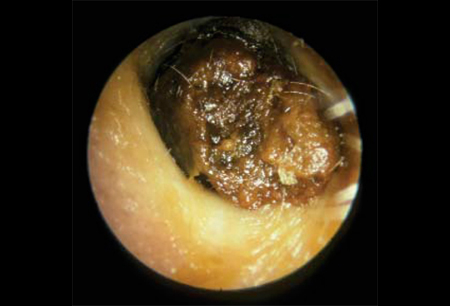Summary
Definition
History and exam
Key diagnostic factors
- visualization of cerumen
- hearing loss
- fullness in the ear
Other diagnostic factors
- otorrhea
- otalgia
- tinnitus
- cough
- vertigo
Risk factors
- age >50 or <5 years
- male sex
- stenotic ear canal
- Down syndrome
- cotton-tipped applicator use
- hearing aid use
- living in a nursing home
Diagnostic tests
Tests to consider
- audiogram
Treatment algorithm
all patients
Contributors
Authors
Stephen Wetmore, MD, MBA, FACS

Professor Emeritus
Department of Otolaryngology
West Virginia University School of Medicine
Morgantown
WV
Disclosures
SW declares that he has no competing interests.
Peer reviewers
Rahul K. Shah, MD, FAAP
Associate Professor of Otolaryngology and Pediatrics
Division of Otolaryngology
Children's National Medical Center
Assistant Professor
Otolaryngology and Pediatrics
George Washington University School of Medicine and Health Sciences
Washington
DC
Disclosures
RKS declares that he has no competing interests.
Seth R. Schwartz, MD, MPH
Director of Research
The Listen For Life Center At Virginia Mason
Otology/Otolaryngology
Department of Otolaryngology
Virginia Mason Medical Center
Seattle
WA
Disclosures
SRS is an author of a reference cited in this topic.
Robin Youngs, MD, FRCS
Consultant Otologist
Gloucestershire Royal Hospital
Gloucester
UK
Disclosures
RY declares that he has no competing interests.
Peer reviewer acknowledgements
BMJ Best Practice topics are updated on a rolling basis in line with developments in evidence and guidance. The peer reviewers listed here have reviewed the content at least once during the history of the topic.
Disclosures
Peer reviewer affiliations and disclosures pertain to the time of the review.
References
Key articles
Schwartz SR, Magit AE, Rosenfeld RM, et al. Clinical practice guideline (update): earwax (cerumen impaction). Otolaryngol Head Neck Surg. 2017 Jan;156(1_suppl):S1-29.Full text Abstract
Roeser RJ, Ballachanda BB. Physiology, pathophysiology, and anthropology/epidemiology of human ear canal secretions. J Am Acad Audiol. 1997 Dec;8(6):391-400. Abstract
Horton GA, Simpson MTW, Beyea MM, et al. Cerumen management: an updated clinical review and evidence-based approach for primary care physicians. J Prim Care Community Health. 2020 Jan-Dec;11:2150132720904181.Full text Abstract
Roland PS, Eaton DA, Gross RD, et al. Randomized, placebo-controlled evaluation of Cerumenex and murine earwax removal products. Arch Otolaryngol Head Neck Surg. 2004 Oct;130(10):1175-7.Full text Abstract
Aaron K, Cooper TE, Warner L, et al. Ear drops for the removal of ear wax. Cochrane Database Syst Rev. 2018 Jul 25;(7):CD012171.Full text Abstract
Reference articles
A full list of sources referenced in this topic is available to users with access to all of BMJ Best Practice.

Differentials
- External otitis
- Keratosis obturans
- Polyp of ear canal
More DifferentialsGuidelines
- Clinical practice guideline (update): earwax (cerumen impaction)
More GuidelinesPatient information
Ear wax
More Patient informationLog in or subscribe to access all of BMJ Best Practice
Use of this content is subject to our disclaimer